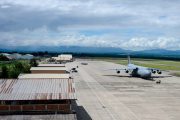
The violence on the Mexican border has proved to be insufficient incentive motivation for the federal government to protect American borders. Instead, it is now prompting the Obama administration to call for an unmanned border crossing with Mexico in order to upgrade security.
The Blaze reports:
This hardly seems a time the U.S. would be willing to allow people to cross the border legally from Mexico without a customs officer in sight. But in this rugged, remote West Texas terrain where wading across the shallow Rio Grande undetected is all too easy, federal authorities are touting a proposal to open an unmanned port of entry as a security upgrade.
By spring of next year, the story says, there is a possibility that kiosks will be placed in Big Bend National Park (pictured above) that would allow people from the Mexican town of Boquillas del Carmen to have their identity documents scanned and be able to communicate with a customs officer who could be as far as 100 miles away.
The Associated Press explains,
The proposed crossing from Boquillas del Carmen leads to a vast expanse of rolling scrub, cut by sandy-floored canyons and violent volcanic rock outcroppings.” The area is home to mountain lions, black bears, and road runners.
The crossing would be maintained by the Customs and Border Protection (CBP). The path would be the nation’s first port of entry with Mexico, and as a result has sparked some fierce controversy.
Rep. Michael McCaul, a Texas Republican who is also a member of the House Homeland Security Committee, questioned whether or not it was wise to use government resources to make crossing the border easier:
We need to use our resources to secure the border rather than making it easier to enter in locations where we already have problems with illegal crossings. There is more to the oversight of legal entry than checking documents. (U.S. Customs and Border Protection) needs to be physically present at every point of entry in order to inspect for contraband, detect suspicious behavior and, if necessary, act on what they encounter.
But supporters have defended its necessity.
“People that want to be engaged in illegal activities along the border, ones that are engaged in those activities now, they’re still going to do it,” said William Wellman, Big Bend National Park’s superintendent. “But you’d have to be a real idiot to pick the only place with security in 300 miles (480 kilometers) of the border to try to sneak across.”
Likewise, Customs and Border Protection officials indicate that the proposal is a safe and effective way of permitting access to Boquillas del Carmen residents, who must travel 240 miles to the nearest legal entry, while simultaneously allowing park visitors to visit the town.
U.S. officials had been discouraging informal crossings after the September 11 attacks provoked calls for tighter security on the border. Since then, Boquillas del Carmen has witnessed a major decline in population — 42 percent, between 2000 and 2010 — while the businesses on the American side began to lose money as a result of border closing.
Gary Martin, who manages a Rio Grande Valley store, stated, “We’re their supply. They don’t have any electricity over there. So they would come here and buy frozen chicken, cake mixes and things that they couldn’t get over there.” Estimating that approximately 40 percent of his revenues came from the residents of Boquillas del Carmen, he explained, “After the border closed, well, I got rid of most of my food and went back to gifts because I wasn’t making any money.”
Very few of the town’s residents risk are making the trip now, explained Martin. “If they get caught over here they get shipped off,” he said. “They get deported all the way to Ojinaga and then they’ve got to find their way home. It’s not really worth it.”
In the meantime, there is a small military presence that protects the town from drug cartel violence.
If the pathway is approved, the Border Patrol would place eight agents to live in the park, in addition to the park’s law enforcement rangers currently living there.
“I think it’s actually going to end up making security better,” CBP spokesman William Brooks said.
“Once you‘ve crossed you’re still not anywhere. You‘ve got a long ways to go and we’ve got agents who are in the area. We have agents who patrol. We have checkpoints on the paved roads leading away from the park.”
The entire project is estimated to cost $2.3 million, and has already provoked the support of the highest levels of government.
As observed by The Blaze, the National Park Service is the “driver behind the project, which it hopes will help conservation efforts on both sides of the border.”
Wellman explains that even with increased cooperation between the National Park Service and the Mexican government, joint conservation has been hindered by the inability of personnel to cross the border without first having to take a 16-hour drive.
As a result, the National Park Service is building a contact station just above the Rio Grande, which is expected to hold CBP kiosks where crossers will be able to scan their documents.
There are already ports of entry in operation on the Canadian border.
“We think we can do this without doing any damage to national security and possibly enhance security along the border by having better intelligence, better communication with people in Mexico,” Big Bend National Park Superintendent Wellman commented.
The proposal is open to public comment through December 27.




